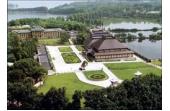The Museum Of Chinese Ancient Chariots
- Things to do
-
- Photo(10)
- Tips&article(9)
- Make it Happen
- Map
-
loading...
Location:
The Museum of Chinese Ancient Chariots is located in the ruins of Hou Li Culture. It is in Houliguan Village, Qiling Town, Linzi District.
Distinctions:
The Museum of Chinese Ancient Chariots combines the excavation site with the exhibition, making the most systematic ancient chariot museum in China, with the largest number of items on display.
Brief Introduction:
The Museum of Chinese Ancient Chariots in Linzi was built based on the immolated chariots and horses of the Spring and Autumn period discovered in Houli, which was one of China's top 10 archaeological discoveries in the year 1990. The museum consists of two parts: Exhibition Hall of Ancient Chariots and the Exhibition Hall of Immolated Chariots and Horses Underground. The Museum of Chinese Ancient Chariots was completed on September 9th, 1994. It is a combination of research achievement on China’s ancient chariots and the quintessence of the different vehicles in the history of China.
The museum consists of two parts: Exhibition Hall of Ancient Chariots and the Exhibition Hall of Immolated Chariots and Horses Underground. Seeing the immolated chariots and horses of the Spring and Autumn period discovered in Houli, people will be amazed at its large scale, completed facilities and the exquisite ornaments of the horses. It can be the best in China and was listed as one of China's top 10 archaeological discoveries.
Items in the Museum of Chinese Ancient Chariots are a comprehensive expression of research achievement on China’s ancient chariots. They show the long history of the chariots in China and the leading position of China in the world history of development of vehicle in terms of technology of making vehicles. Ji Xia Amusement Park in the museum is composed of several parts including Exhibition Hall of Folk-customs, Entertainment Area of Folk-customs, Niao Yu Lin (Forest of Birds’ Sing), Archery Field, Botanic Garden, Bonsai Garden, Racw-way for Vehicles and sop on.
How to Get There:
Tourists can take Bus 73 in the central city of Zibo and get off at the Museum of Chinese Ancient Chariots.
Tips & articles
|
|
|
forum discussion
|
|
|










